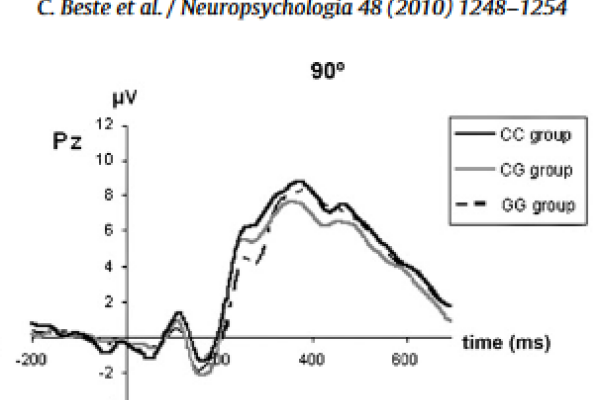2009-12-22

Numerous lines of research indicate that attentional processes, working memory and saccadic processes are highly interrelated. Even though this relation has often been postulated in literature, the neurobiological mechanism underlying this interrelation, are not understood. In the current study, we examine the relation between these processes with respect to their cognitive-neurophysiological and neurobiological background by means of event-related potentials (ERPs) in a sample of N = 72 healthy probands characterized for the functional serotonin receptor 1 A (5-HT1A) C(−1019)G polymorphism. The results support a close interrelation between working memory, attentional and saccadic processes. Yet, these processes are differentially modulated by the 5-HT1A C(−1019)G polymorphism. The 5-HT1A C(−1019)G polymorphism primarily affects attentional processing, whereas processes related to the mental rotation of an object are independent of 5-HT1A genetic variation. It is shown that an increasing number of −1019 G alleles leads to a differential reduction of the N1 above the left and right hemisphere and hence bottom-up attentional processing. In the way increasing numbers of −1019 G alleles lead to a reduction of attentional processes, saccadic activity increases as a similar function of the number of −1019 G alleles. This increase in activity occurs parallel in time to the process of mental rotation. It is hypothesized that decreased attentional processes, dependent on different 5-HT1A C(−1019)G genotypes, may cause parietal networks to increase saccadic activity in order to perform mental rotation. The results support theories of highly interlinked attention, working memory and eye-movement systems.

Numerous lines of research indicate that attentional processes, working memory and saccadic processes are highly interrelated. Even though this relation has often been postulated in literature, the neurobiological mechanism underlying this interrelation, are not understood. In the current study, we examine the relation between these processes with respect to their cognitive-neurophysiological and neurobiological background by means of event-related potentials (ERPs) in a sample of N = 72 healthy probands characterized for the functional serotonin receptor 1 A (5-HT1A) C(−1019)G polymorphism. The results support a close interrelation between working memory, attentional and saccadic processes. Yet, these processes are differentially modulated by the 5-HT1A C(−1019)G polymorphism. The 5-HT1A C(−1019)G polymorphism primarily affects attentional processing, whereas processes related to the mental rotation of an object are independent of 5-HT1A genetic variation. It is shown that an increasing number of −1019 G alleles leads to a differential reduction of the N1 above the left and right hemisphere and hence bottom-up attentional processing. In the way increasing numbers of −1019 G alleles lead to a reduction of attentional processes, saccadic activity increases as a similar function of the number of −1019 G alleles. This increase in activity occurs parallel in time to the process of mental rotation. It is hypothesized that decreased attentional processes, dependent on different 5-HT1A C(−1019)G genotypes, may cause parietal networks to increase saccadic activity in order to perform mental rotation. The results support theories of highly interlinked attention, working memory and eye-movement systems.